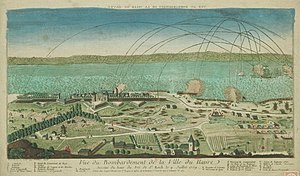Raid_on_Le_Havre
Raid on Le Havre
1759 military operation
The Raid on Le Havre was a two-day naval bombardment of the French port of Le Havre early in July 1759 by Royal Navy forces under Rear-Admiral George Rodney during the Seven Years' War, which succeeded in its aim of destroying many of the invasion barges being gathered there for the planned French invasion of Great Britain.[1]
| Raid on Le Havre | |||||||
|---|---|---|---|---|---|---|---|
| Part of the Seven Years' War | |||||||
 Vue generale du bombardement du Havre en 1759 par les Anglais, Joseph-Abel Couture | |||||||
| |||||||
| Belligerents | |||||||
|
|
| ||||||
| Commanders and leaders | |||||||
|
|
| ||||||
| Strength | |||||||
|
5 ships of the line 5 frigates 1 sloop 6 bomb ketches |
8,000 12 prams 337 barges[1] | ||||||
| Casualties and losses | |||||||
| Light | Many barges destroyed | ||||||
By the summer of 1759 the duc de Choiseul's invasion plans was under way with intensive naval preparations taking place along the French ports in the Atlantic and in the channel – Brest, Le Havre, Rochefort and Toulon. Troops were assembled at number of points principally at Dunkirk, Saint-Omer, Ostend, Lille and Vannes.[2] Choiseul had decided that the Le Havre was to be the main base for the Prince de Soubise's strike at England as it lay on the Seine and troop movement was far easier than any other French port.[2]
The British had received intelligence that the French had a number of flat bottomed boats were prepared at Le Havre for the purpose of disembarking troops.[3]
The squadron Admiral Rodney was detached in the beginning of July with a small squadron and sailed from Spithead on 2 July, arrived off Le Havre.
Rodney's squadron consisted of the 60-gun ship of the line Achilles as flagship, four 50-gun ships, five frigates, a sloop, and six bomb ketches and anchored there placing the bomb vessels in the narrow channel of the river leading to Honfleur. The next day the attack commenced on the flat-bottomed boats and supplies which had been collected there. Over 3000 shells were fired at the principal targets – the magazines, batteries and the boats as well as into the town for fifty consecutive hours.[3] Rodney, with some of his frigates, remained off the port for the rest of the year, and captured numerous prizes.[4]
The bombardment did immense damage, while Rodney's fleet received little harm in return.[1] A numerous body of French troops came down to the shore and under the cover of entrenchments and batteries kept up an active fire upon the assailants. The town was set on fire in several places and burned with great fury while the inhabitants fled.[3]
The success of the venture, however, lured the British commanders into a false sense of security, making them believe it had been a greater setback than it had. The French intended to capitalise on this, but scaled back their initial plans instead.[5]
In summer 1759, the French Toulon fleet sailed out through the Straits of Gibraltar but was caught and defeated by a British fleet at the Battle of Lagos in August. In November of that year, the French Brest Squadron was handily defeated at the Battle of Quiberon Bay. With these two defeats combined – the invasion plans received a crippling blow.[4]
The victory helped contribute to what became known as the Annus Mirabilis in Great Britain.
- Ships of the line
- Achilles (60), flagship, Captain Samuel Barrington
- Chatham (50), Captain John Lockhart
- Deptford (50), Captain John Hollwell
- Isis (50), Captain Edward Wheeler
- Norwich (50), Captain George Darby
- Frigates
- Brilliant (36), Captain Hyde Parker
- Juno (36), Captain Henry John Philips
- Vestal (32), Captain Samuel Hood
- Boreas (28), Captain Robert Boyle
- Unicorn (28), Captain Thomas Graves
- Sloop
- Wolf (8), Commander Hugh Bromedge
- Bomb ketches
- Furnace, Commander Jonathan Faulknor
- Firedrake, Commander James Orrok
- Basilisk, Commander John Clarke
- Mortar, Commander Joseph Hunt
- Carcass, Commander Charles Inglis
- Blast, Commander Thomas Willis
- Notes
- McLynn (2015) pp 96-97
- McLynn (2011) pp 239-40
- Cust, Edward (1862). 1739-1759 Volume 2 of Annals of the Wars of the Eighteenth Century. J. Murray. p. 291.
- Clowes, William Laird (1898). The Royal Navy: A History From the Earliest Times to the Present. Vol. III. London: Sampson Low, Marston & Company. pp. 215–216.
- McLynn (2011) p 244
- Bibliography
- McLynn, Frank (2015). From The Armada to Hitler. Crux Publishing Ltd. ISBN 9781909979314.
- Russell Frank Weigley, The age of battles, p. 226
- McLynn, Frank (2011). 1759: The Year Britain Became Master of the World. Random House. ISBN 9781446449271.
- Schumann, Schweizer, Matt & Karl (2012). The Seven Years War: A Transatlantic History War, History and Politics. Routledge. ISBN 9781134160686.